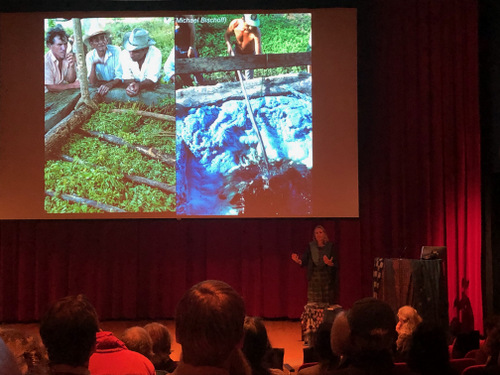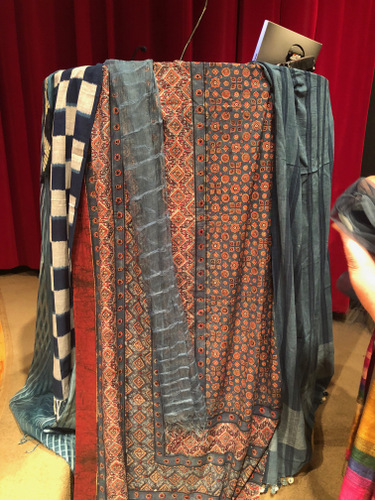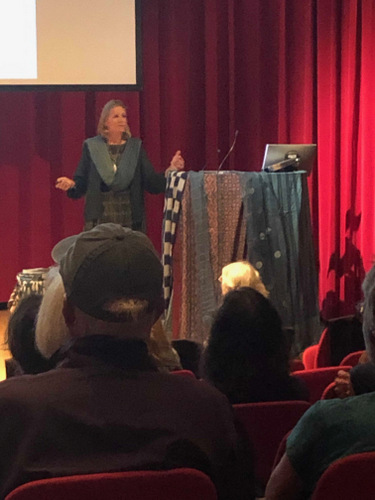This has been an olympically busy week, and all of it was unexpected. We had an unplanned visit from Bob’s brother at the beginning of the week, which made my mother in law’s 90th birthday truly special. Boating friends have arrived via sailboat midweek, and we want to spend time with them. Bob is up to his chin provisioning our boat Pandora for his departure next week for points south, leading down to Antigua in the Caribbean. This is a giant hurdle for us each year, because all our clothing, all my textile projects, and all our food staples have to get onboard before Bob sets sail. We will not be able to ship any of these items, or take that much stuff on a plane!
And to top off a week of fun but unexpected pleasures (read hectic), I got an email about a presentation at Yale Art Gallery that I simply had to attend, no matter how much schedule rearranging it necessitated!
I expected to spend the next two blog posts sharing some textile-y experiences I enjoyed in France, but I need to interrupt that program to talk about last night’s presentation at Yale. The speaker was Jenny Balfour-Paul! I certainly was not going to miss a chance to meet this fascinating woman who has done so much research into the world cultures that have a long history of dyeing with indigo. Two years ago, my local weaving group read her most recent book Deeper than Indigo and then spent our September meeting discussing the book. Indigo is such a fascinating subject! How did anyone ever figure out how to extract that wonderful blue from the plant? It seems like alchemy, especially since the dye itself is not blue, and when you pull your yarn or fabric from the dye vat, it does not turn blue for several seconds. It starts yellow and goes deep green before finally turning blue. It’s quite a magical experience, and I can imagine how ancient cultures who had no knowledge of the chemistry involved, must have marveled at this mysterious process. The Indians and Japanese always prayed to their indigo god before beginning a dye session, and they always gave thanks to that god at the end.

Jenny Balfour Paul has been researching indigo for over 40 years. If I wrote about all I learned about her last night, this post would be far more than a little digression. She is a living treasure on the history of indigo, and she has traveled all the parts of the world where indigo dyeing was done in ancient times, and the parts of the world where indigo dyeing was big business during the colonial expansion era of the Western world. Recently, she’s been involved in projects for creating textiles with less impact on our fragile ecological system. She will be talking about that on Monday, next week, at the Explorers’ Club in Manhattan. You can read about the project here. Her first exploration, 40 years ago, was to the Middle East, where traditional dyeing techniques were fading into obscurity. She wanted to record those techniques in order to preserve them. Considering the language barrier between her and these remote tribes, she mostly gained knowledge of their dyeing process by watching them. This included seeing the plants grown in the fields, harvesting, and the complex process of turning plant into dye. After the Middle East and North Africa, her research has taken her to the Far East, to remote parts of China, to remote parts of both Africa and India, to the South America and the tropical islands where Western ventures into mass production of shippable dye stuffs took place during the colonial period. One of the most fascinating projects she’s working on is using indigo cakes that were recovered from a shipwreck in the Marquesa islands in the late 17th c. She let us all hold one of the indigo cakes, and it looked brand new, even after being submerged for centuries.
For her presentation last night, Jenny draped the podium in beautiful indigo fabrics


She wore a stunning outfit of indigo dyed fabrics. Her beautiful dress was dyed by her first teacher who set her on the path of researching the dyeing traditions of other cultures. The colors in my photo are quite ‘off’ due to the stage lighting. Her silk scarf is really a deep blue touched with subtle shades of green. Her beautifully printed dress fabric is what her teacher dyed. It has a lot of green in it, and also tan from where it was tied to create rows of resist. It is also patterned with tiny dots where her teacher used a wooden block with nails, dipped in wax, to add resist to the fabric (like batik) before dyeing.

I was thoroughly enchanted with Jenny Balfour Paul, both as a dedicated researcher and as someone who was refreshingly passionate about her subject. Her enthusiasm is contagious! When I spoke to her after the presentation I admitted my lack of confidence in dyeing, especially with indigo. I’ve had some successes, but only using someone else’s dyebath. I’ve been fortunate during my time in Connecticut to have other guild members share their indigo vats me. Last night Jenny gave me a bit more confidence to try again to make my own vat. She recommended the indigo kit from Maiwa. I’m on it!
And so goes a short digression. Like many things, this is going to send me down a deep rabbit hole. But I’m looking forward to gaining some confidence in dyeing with indigo. I wonder what Bob would think of that as a project onboard this winter. Hmmmm….

Woah! So cool that you got to hear her speak!